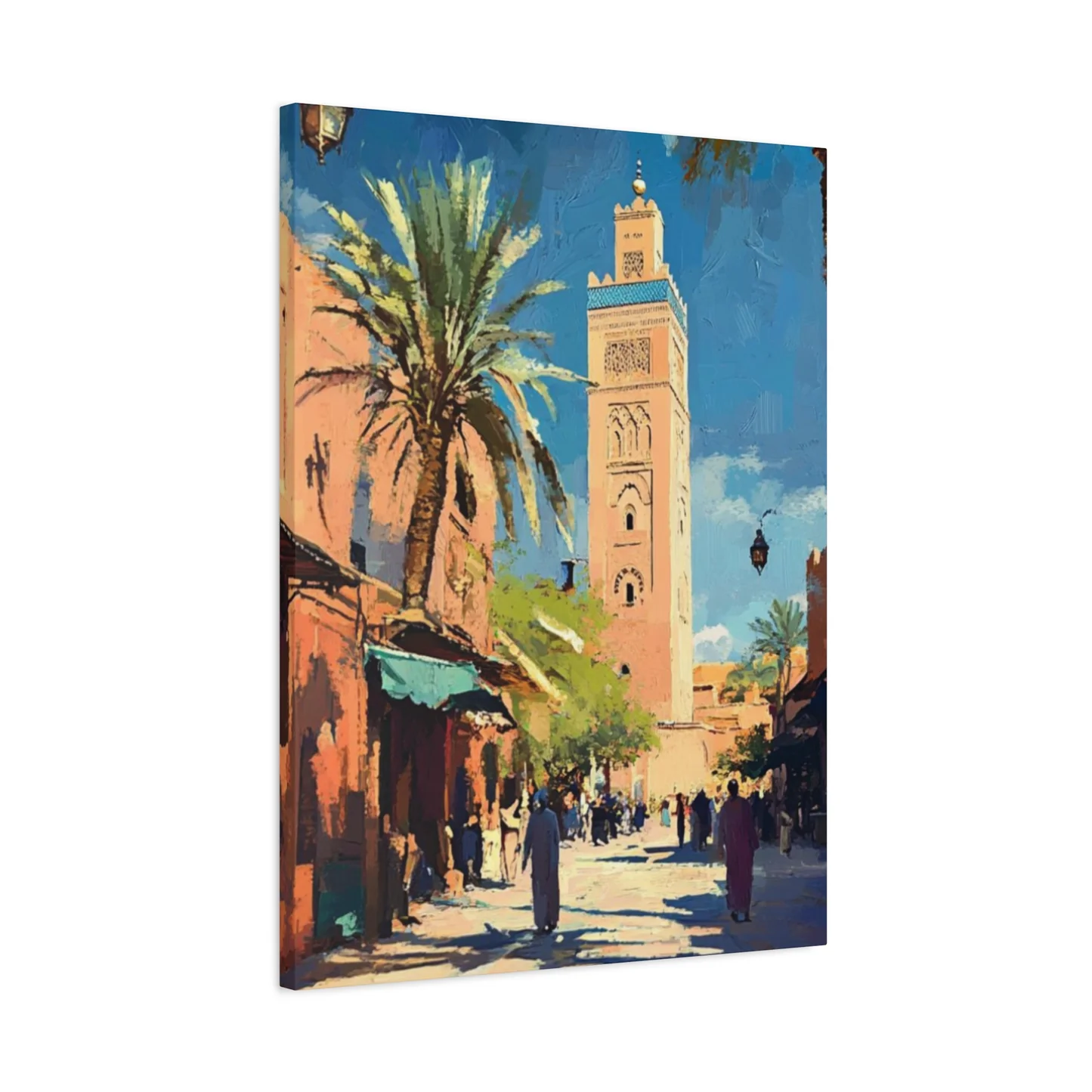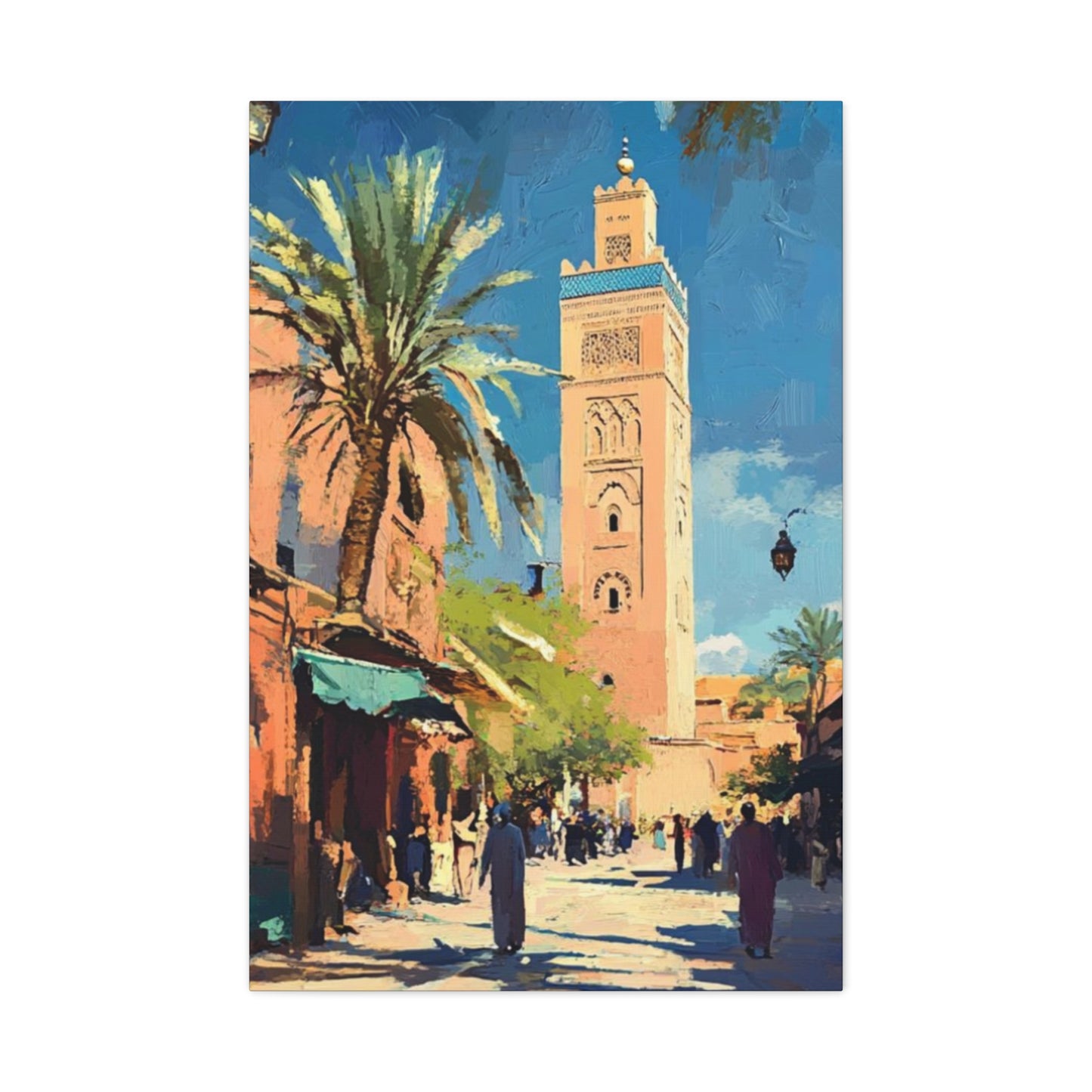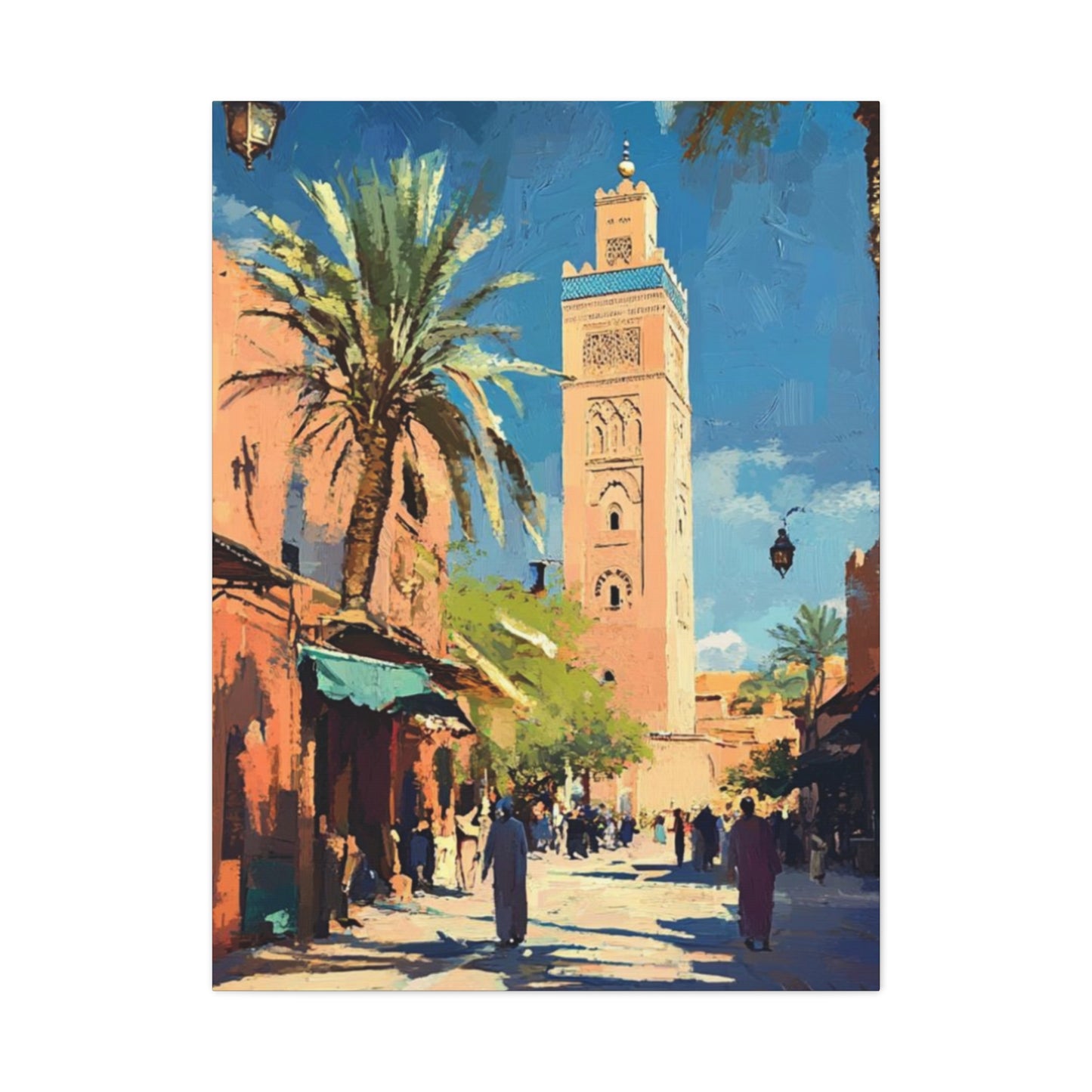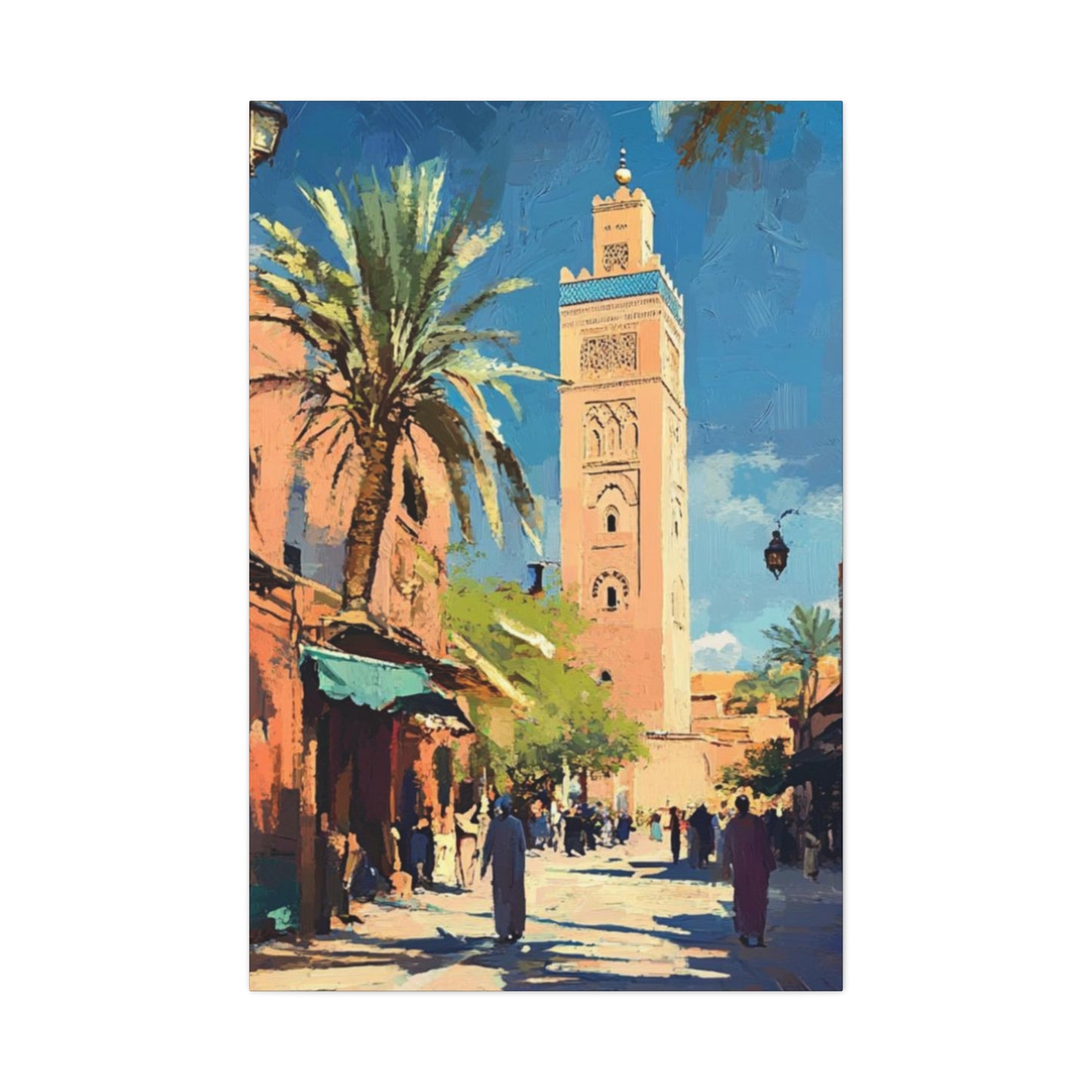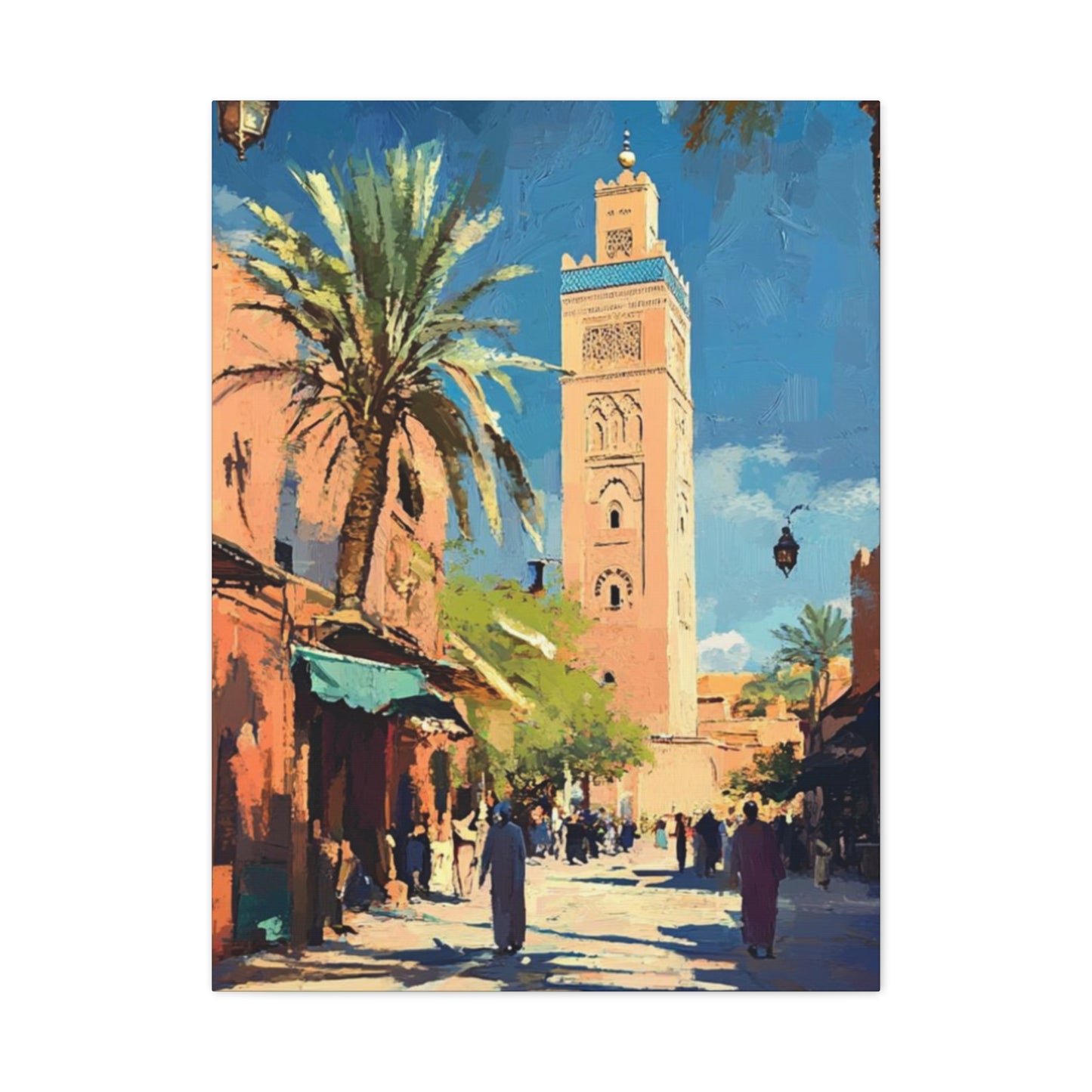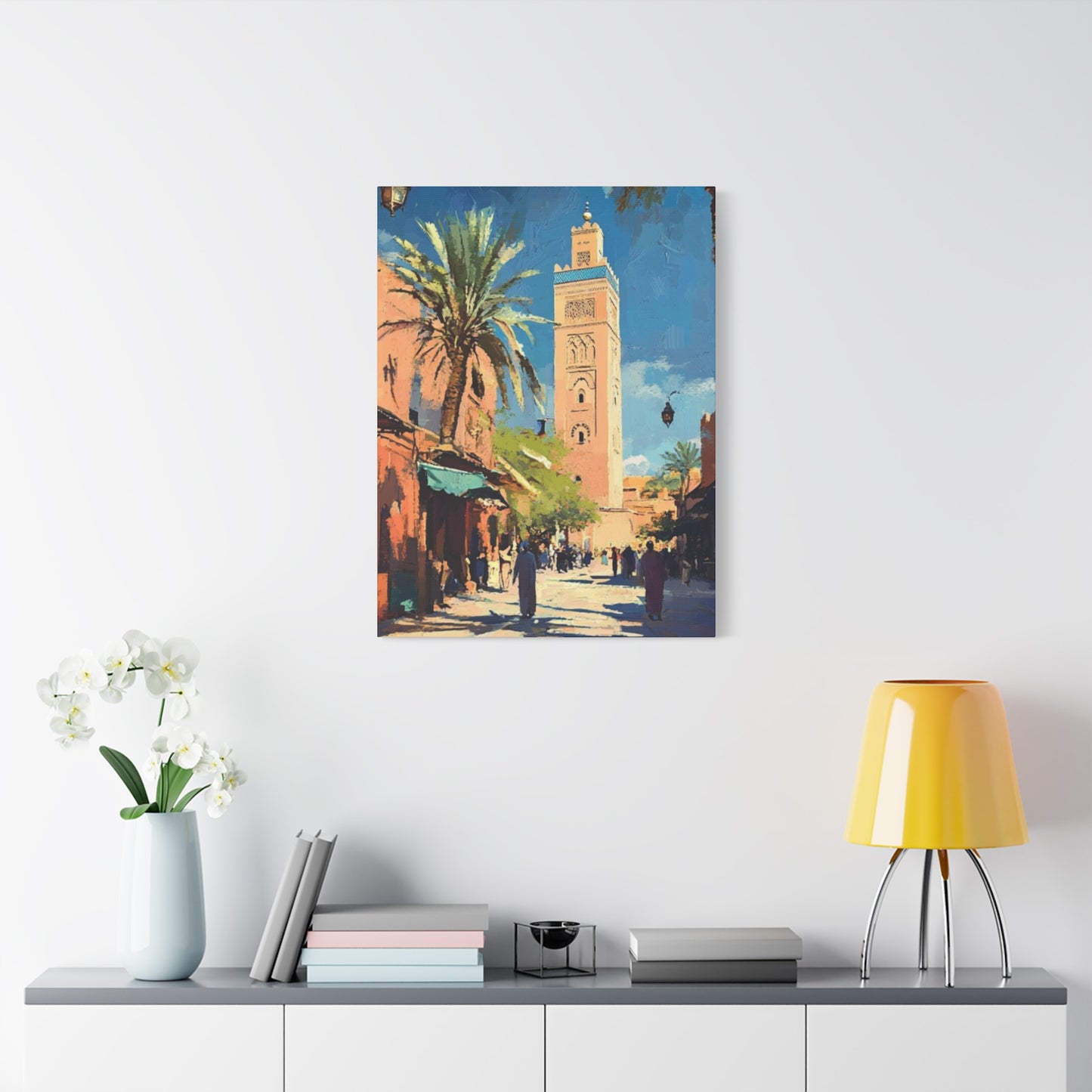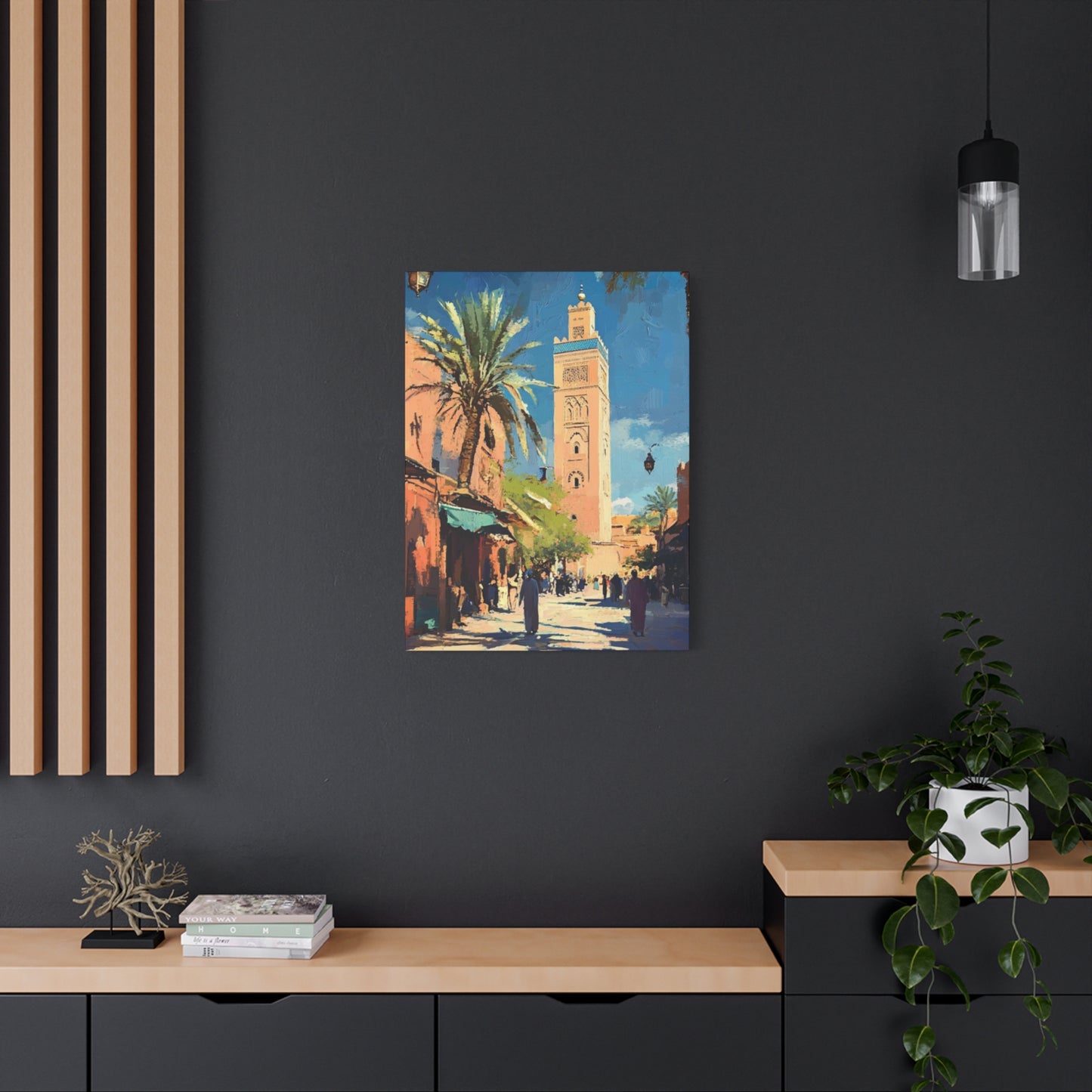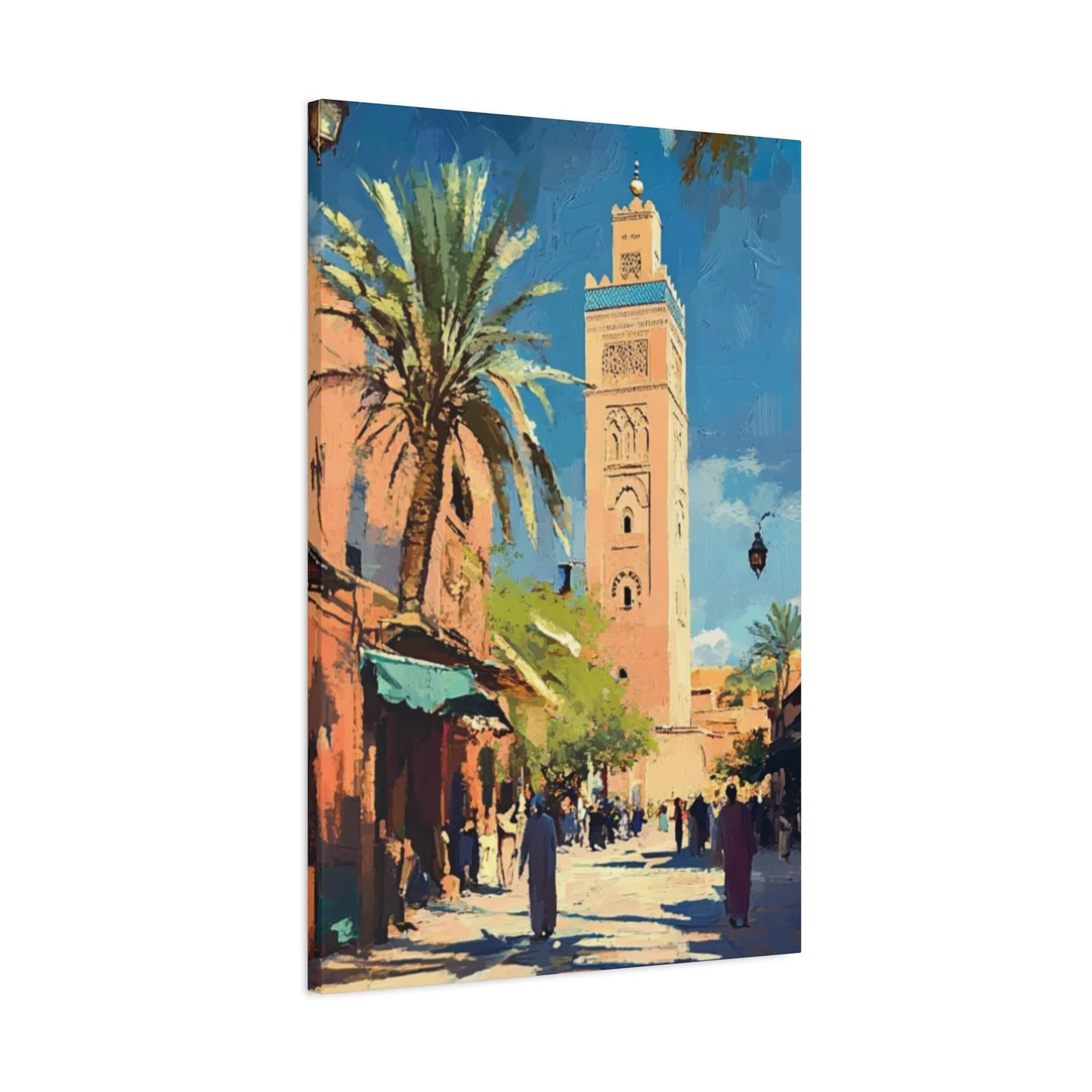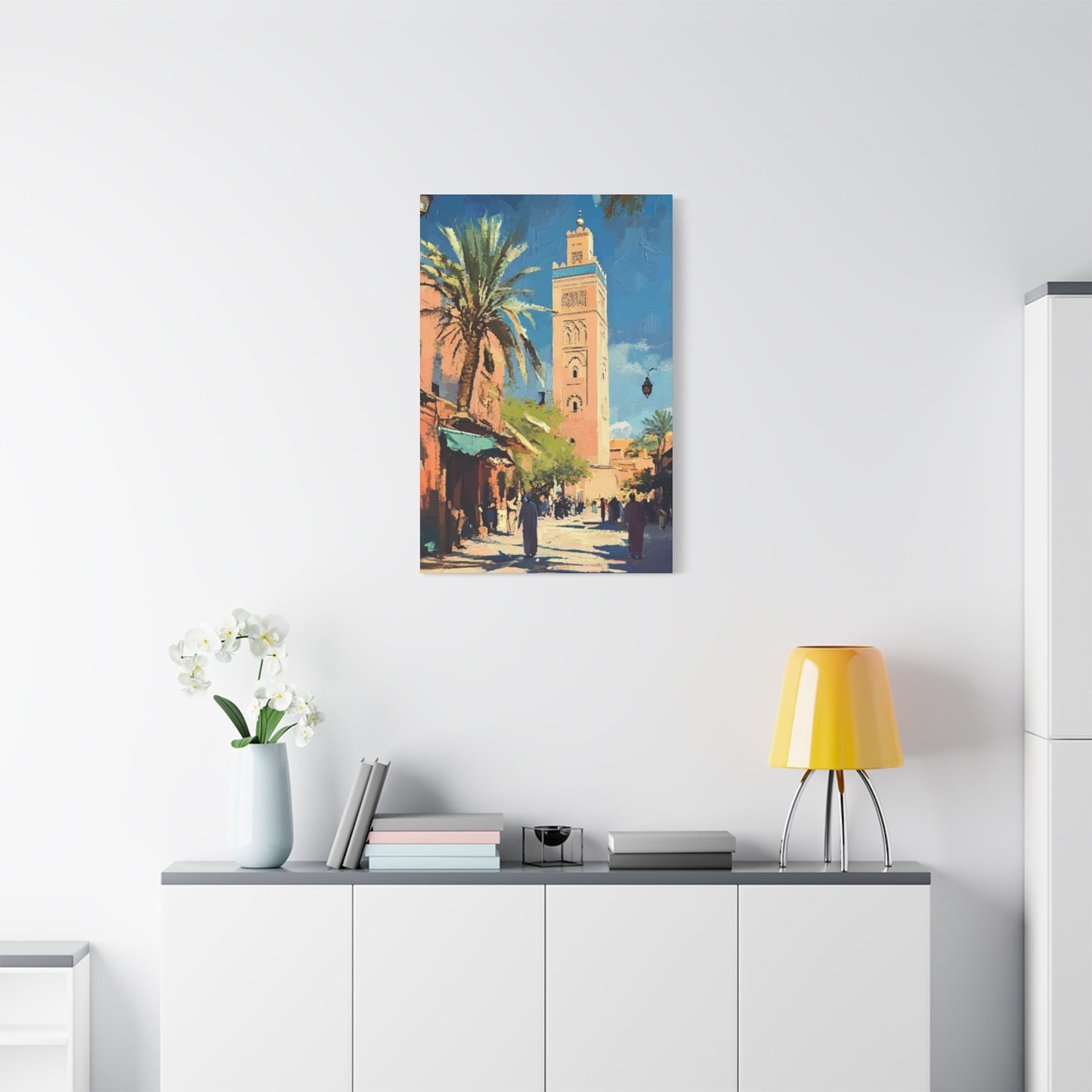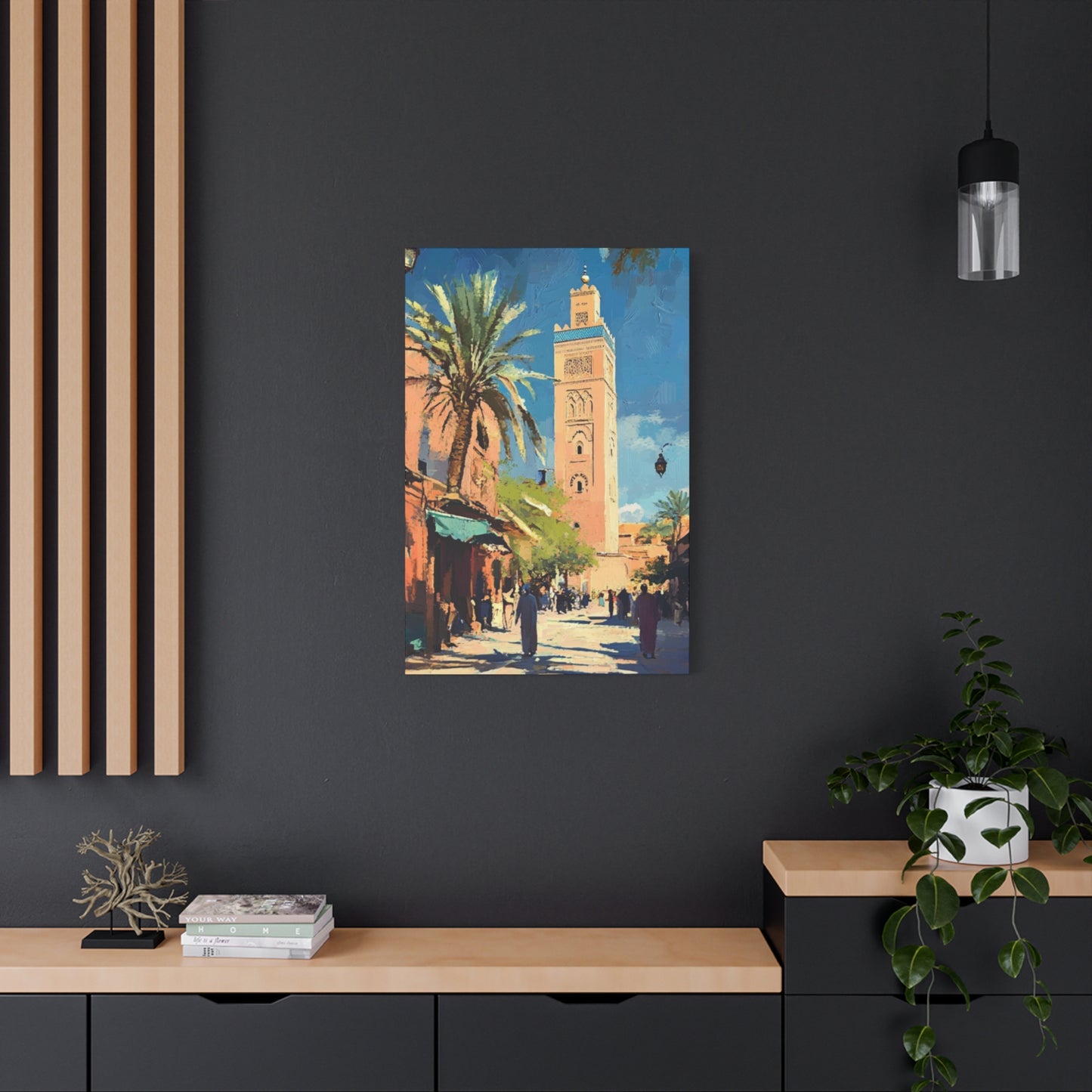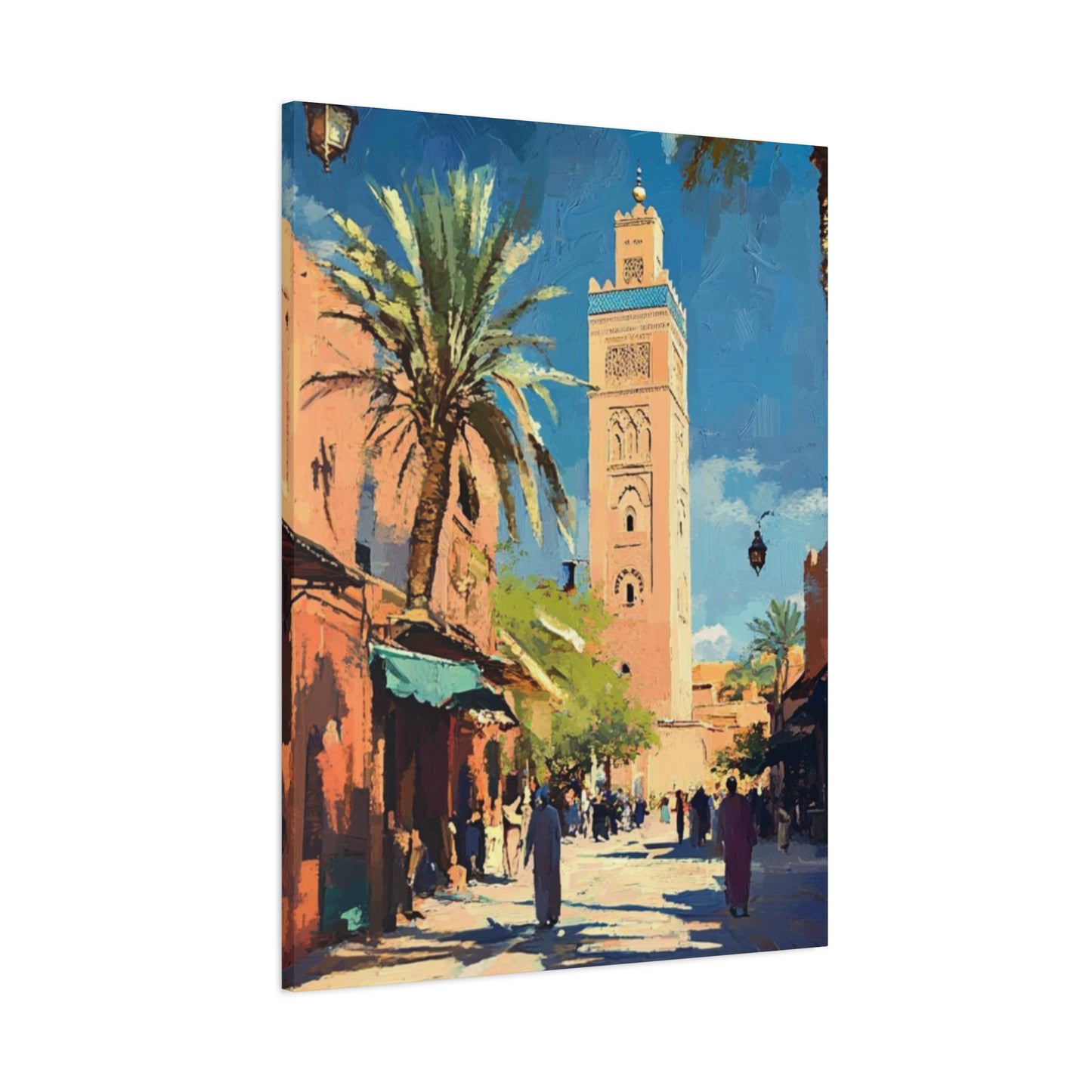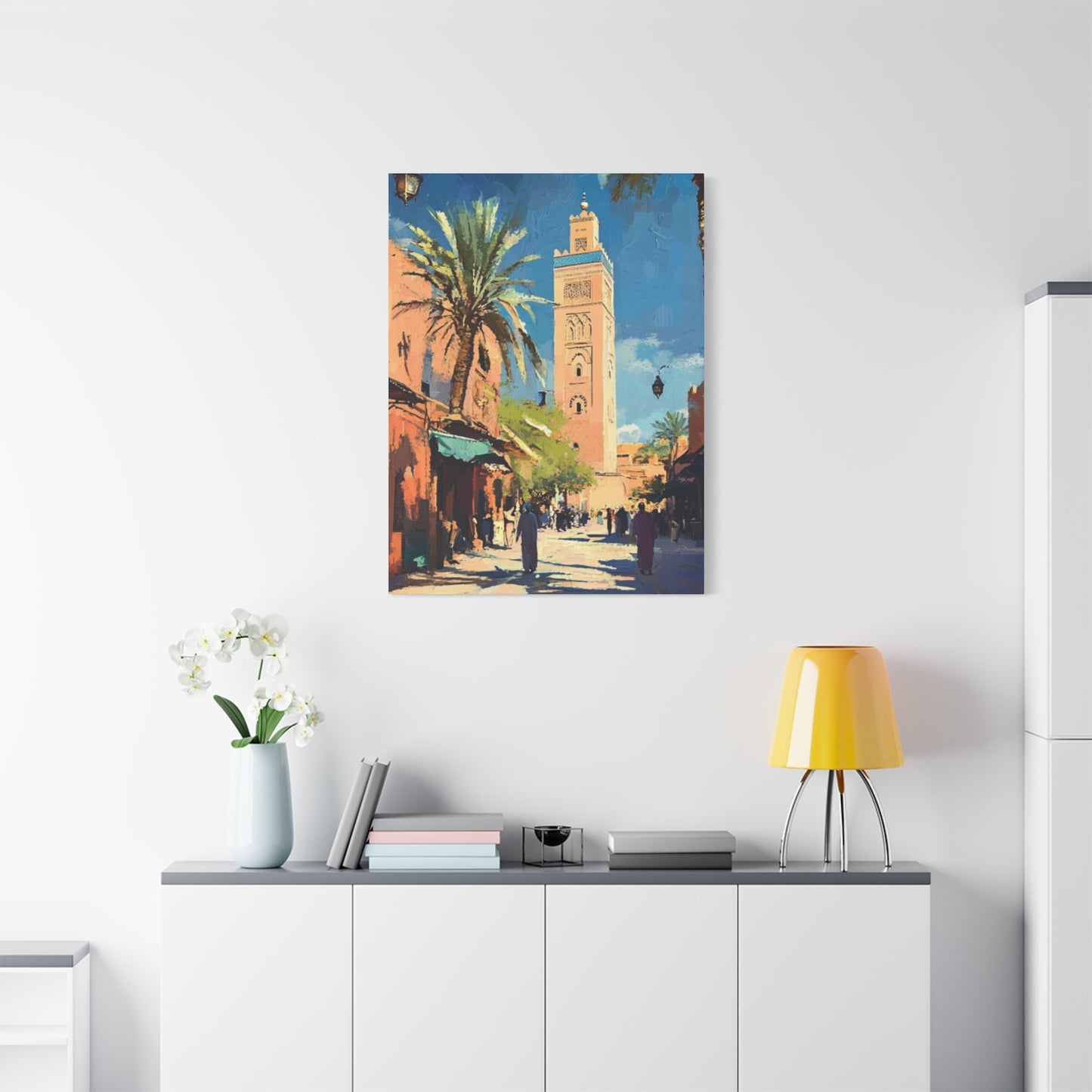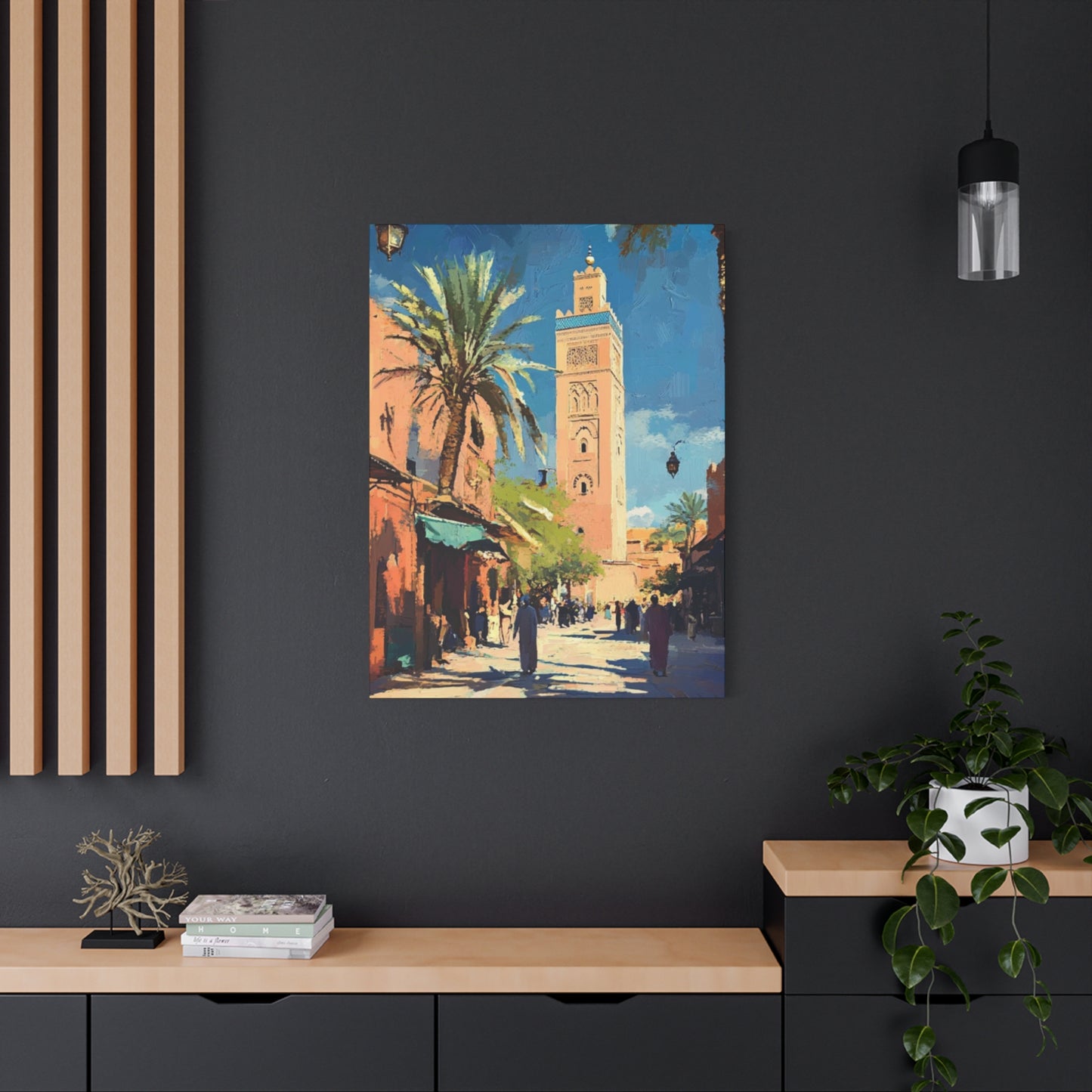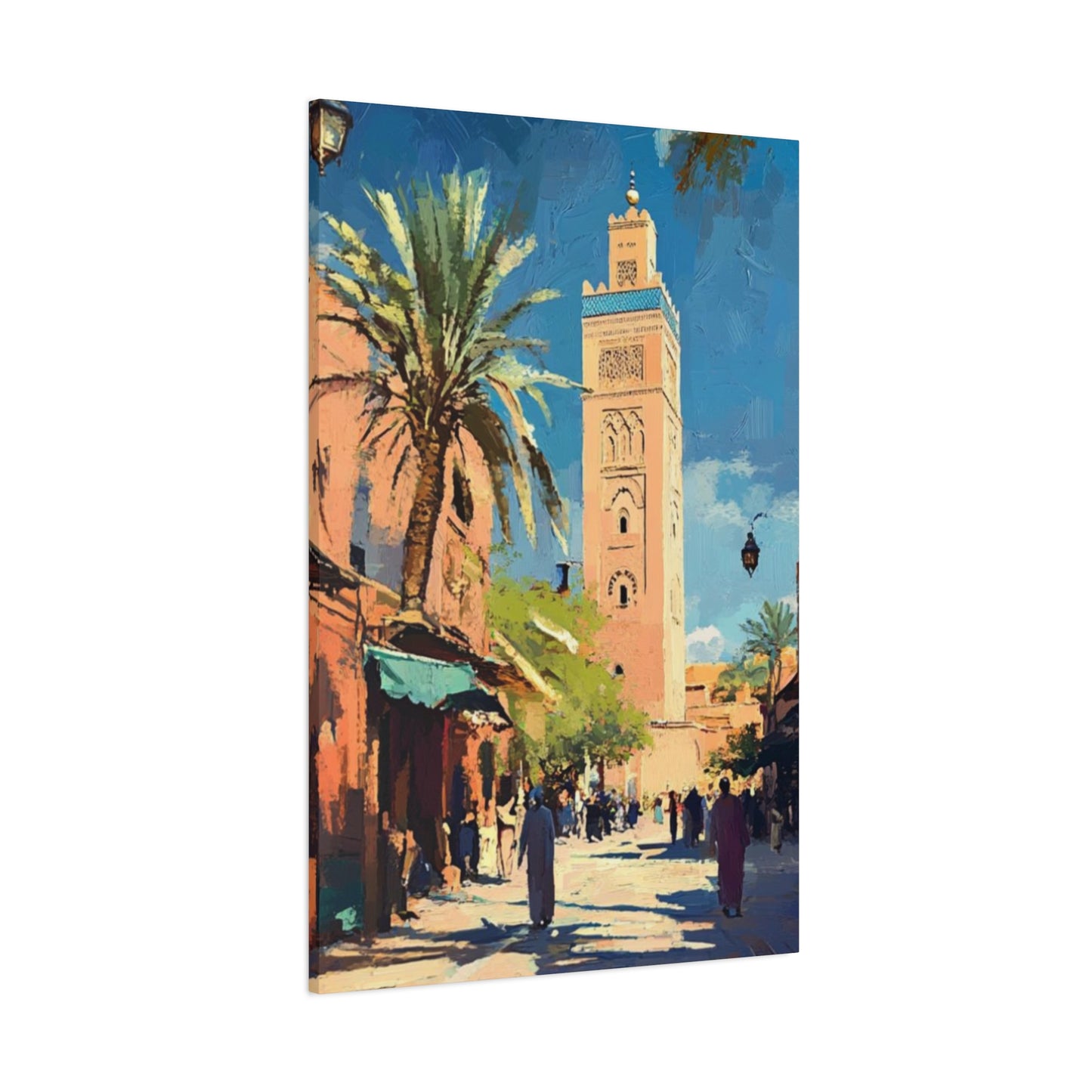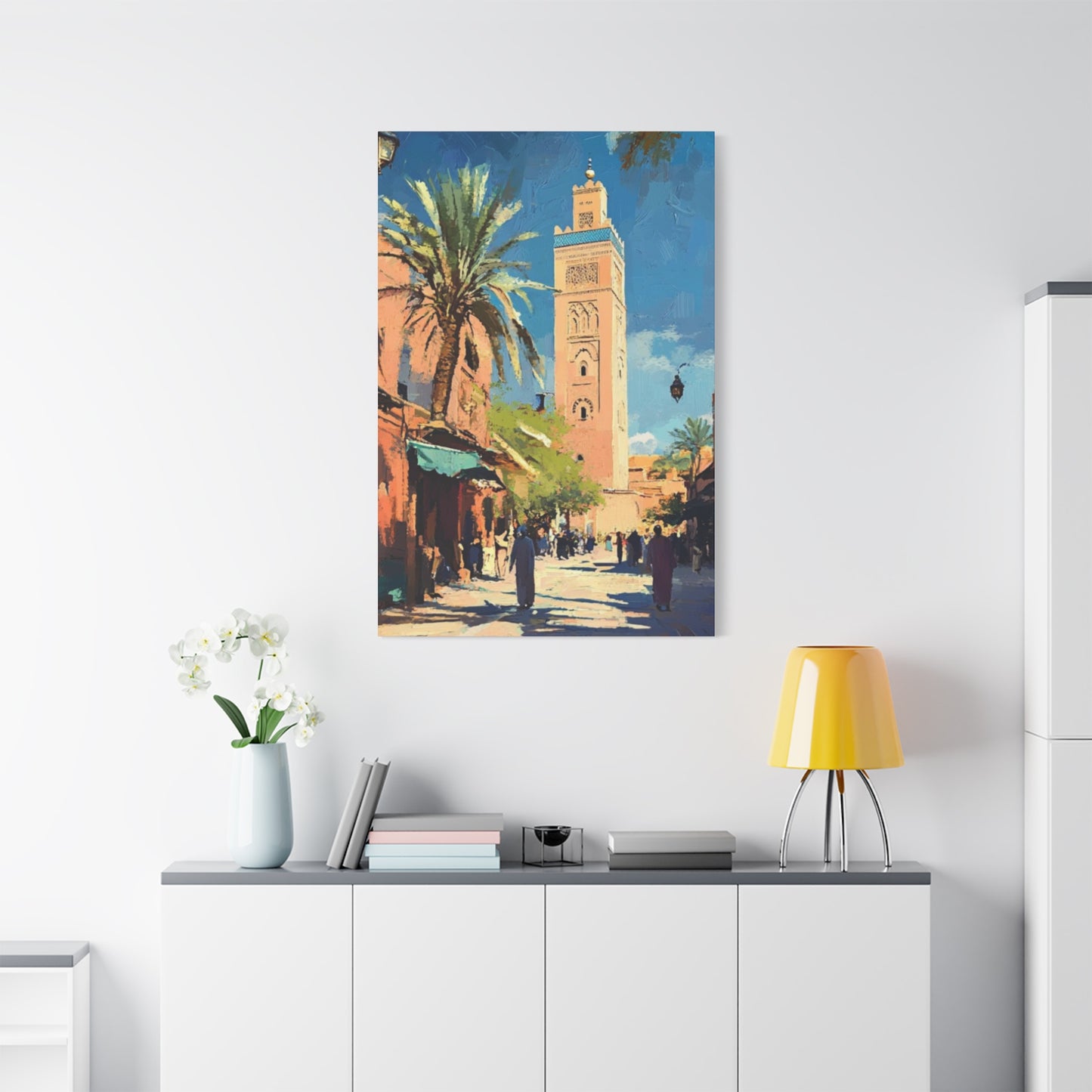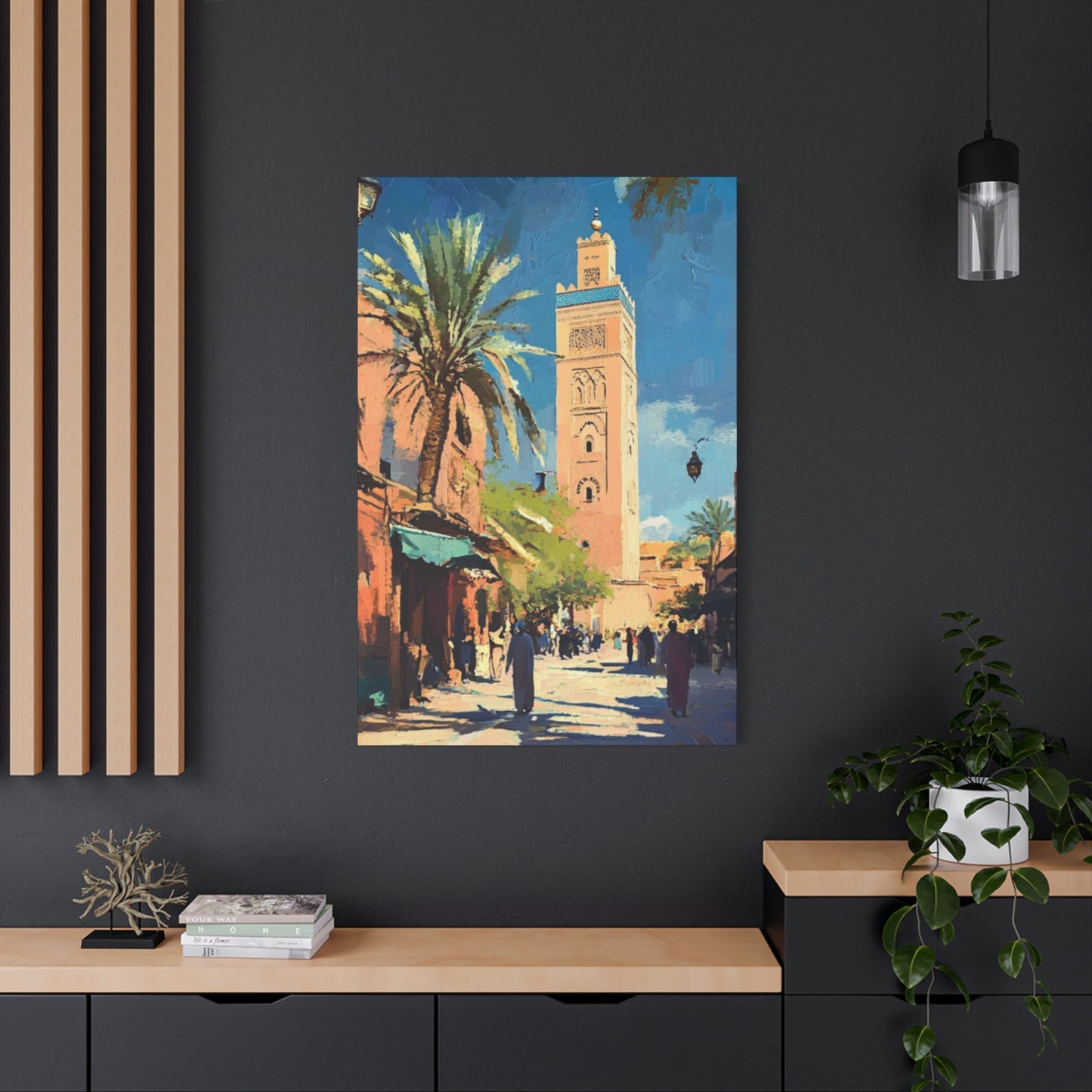Moroccan Cityscape Wall Art: Bringing Exotic Urban Beauty to Your Home
Morocco's magnificent cities have captivated artists and admirers for centuries, offering a visual feast of architectural marvels, bustling markets, and breathtaking landscapes that translate beautifully into wall art. From the rose-colored walls of Marrakech to the striking blue buildings of Chefchaouen, these urban environments provide endless inspiration for creating stunning visual displays that can transform any living environment.
The allure of Moroccan urban landscapes lies in their unique blend of ancient traditions and vibrant contemporary life. These cities showcase intricate Islamic architecture, winding medieval streets, colorful souks, and dramatic natural settings that create compelling subjects for artistic expression. When translated into wall art, these elements bring an exotic sophistication and cultural richness that can elevate any room's aesthetic appeal.
Artists and photographers worldwide have been drawn to Morocco's cities for their extraordinary visual elements. The interplay of light and shadow across traditional buildings, the geometric patterns adorning doorways and windows, and the warm, earthy color palettes create compositions that are both visually striking and emotionally evocative. These characteristics make Moroccan cityscape wall art particularly effective for creating focal points in residential and commercial environments.
The popularity of Moroccan cityscape wall art continues to grow as people seek to incorporate global influences into their personal environments. This artistic style offers viewers an opportunity to experience the magic of distant places while enjoying the comfort of their own homes. Whether displayed as large-scale photography, detailed paintings, or stylized illustrations, these urban scenes provide a window into Morocco's rich cultural heritage and stunning natural beauty.
Vibrant Moroccan Cityscapes in Art
Morocco's cities present artists with an incredible array of visual elements that translate magnificently into vibrant wall art pieces. The country's urban environments are characterized by their intense colors, dramatic lighting, and unique architectural styles that have evolved over thousands of years. These elements combine to create cityscapes that are both historically significant and aesthetically captivating.
The vibrancy of Moroccan cityscapes stems from several key factors that make them particularly appealing as art subjects. The region's intense sunlight creates dramatic contrasts between light and shadow, highlighting architectural details and creating depth in urban scenes. This natural lighting enhances the warm earth tones that dominate many Moroccan cities, from the famous pink walls of Marrakech to the golden limestone buildings found throughout the country.
Color plays a crucial role in defining the character of Moroccan urban environments. Unlike many Western cities that feature predominantly gray and neutral tones, Moroccan cities burst with color at every turn. Traditional buildings often feature vibrant blues, greens, and terracotta reds that have been used for centuries. These colors are not randomly chosen but have cultural and practical significance, with blue representing protection from evil spirits and earthy tones helping buildings blend with the natural landscape.
The geometric patterns that adorn Moroccan architecture add another layer of visual interest to cityscape art. Islamic geometric patterns, known as arabesques, appear on everything from doorways to entire building facades. These intricate designs create visual rhythm and movement within static architectural elements, making them particularly effective when captured in artistic representations. The repetition and variation of these patterns provide artists with rich material for creating dynamic compositions.
Street life in Moroccan cities adds another dimension of vibrancy to cityscape art. The bustling activity of markets, the colorful clothing of residents, and the various modes of transportation create dynamic scenes that capture the energy and spirit of these urban environments. Artists often incorporate these human elements to bring life and movement to their cityscape compositions, creating pieces that tell stories about daily life in these fascinating urban centers.
The architectural diversity found in Moroccan cities provides artists with numerous subject options. From ancient kasbahs and traditional riads to French colonial buildings and modern structures, these cities showcase a remarkable range of architectural styles. This diversity allows artists to explore different visual themes within the broader context of Moroccan cityscape art, creating pieces that highlight specific architectural elements or present comprehensive urban panoramas.
Moroccan cityscapes also benefit from their dramatic natural settings. Many cities are positioned against mountain backdrops or near desert landscapes, creating striking contrasts between built environments and natural features. These geographical elements add depth and context to cityscape art, providing artists with opportunities to explore themes of civilization and nature, tradition and modernity.
The seasonal variations in Moroccan cities add another layer of artistic possibility. The quality of light changes throughout the year, creating different moods and atmospheres that can be captured in art. Spring brings blooming flowers and fresh colors, while summer intensifies the warm tones that characterize these urban environments. Winter provides clearer air and different lighting conditions that reveal architectural details with particular clarity.
Contemporary Moroccan cityscape art often incorporates modern artistic techniques while respecting traditional visual elements. Artists may use photography, digital manipulation, painting, or mixed media to create pieces that honor the historical character of these cities while presenting them through contemporary artistic lenses. This approach allows for fresh interpretations of familiar subjects while maintaining the essential characteristics that make Moroccan cityscapes so visually compelling.
Capturing Marrakech's Colors in Wall Art
Marrakech, known as the "Red City," offers artists an extraordinary palette of colors that create some of the most striking cityscape wall art available today. The city's distinctive rose-colored buildings, created using local clay and limestone, provide a warm, unified base that is enhanced by vibrant accents throughout the urban landscape. This unique color scheme makes Marrakech cityscape art particularly effective for creating warm, inviting atmospheres in residential and commercial settings.
The foundation of Marrakech's visual appeal lies in its famous red buildings, which derive their color from the local materials used in construction. The red ochre clay mixed with limestone creates walls that range from pale pink to deep terracotta, depending on the time of day and lighting conditions. This color variation provides artists with rich material for creating nuanced compositions that capture the subtle shifts in tone that occur throughout the day.
Beyond the signature red buildings, Marrakech offers artists a wealth of additional colors that create vibrant contrasts and visual interest. The city's numerous gardens feature lush greens that provide cooling visual relief against the warm building tones. Palm trees and other vegetation create natural color accents that add life and freshness to urban scenes. These green elements are particularly effective in wall art as they provide balance and prevent the warm tones from becoming overwhelming.
The markets and souks of Marrakech introduce another layer of color complexity that artists frequently incorporate into their work. Vendors display colorful textiles, spices, ceramics, and crafts that create rainbow-like displays throughout the marketplace areas. These commercial activities add human interest and cultural authenticity to cityscape art while providing opportunities for artists to explore themes of commerce, tradition, and daily life.
Traditional Moroccan tiles, known as zellige, appear throughout Marrakech and provide artists with intricate patterns and brilliant colors to incorporate into their work. These handcrafted tiles feature deep blues, emerald greens, bright whites, and rich browns that create geometric patterns on fountains, doorways, and building accents. The reflective quality of these tiles adds luminosity to urban scenes and creates focal points within larger compositions.
The play of light and shadow in Marrakech creates dramatic visual effects that skilled artists capture in their cityscape work. The intense North African sun creates sharp contrasts between illuminated surfaces and deep shadows, particularly in the narrow streets and covered passages that characterize much of the old city. These lighting conditions create natural drama and depth that translate effectively into two-dimensional art forms.
Water features throughout Marrakech add another color dimension that artists frequently explore. Fountains, reflecting pools, and irrigation channels introduce cool blue tones that provide visual relief and create points of tranquility within busy urban scenes. The reflective qualities of water also allow artists to explore interesting compositional techniques, using reflections to create symmetry or to introduce inverted architectural elements.
The clothing and textiles worn by Marrakech residents contribute significantly to the city's visual richness. Traditional robes in various colors, colorful head coverings, and ornate jewelry create moving elements of color throughout the cityscape. Artists often incorporate these human elements to add life and authenticity to their work while showcasing the cultural aspects that make Marrakech unique.
Seasonal variations in Marrakech's colors provide artists with different interpretive possibilities. Spring brings blooming bougainvillea and other flowering plants that add bright pinks and purples to the urban palette. Summer intensifies all colors due to the strong sunlight, while winter provides more subtle tones and clearer air that reveals architectural details with particular clarity.
Contemporary artists working with Marrakech cityscapes often experiment with color enhancement and interpretation while maintaining the essential character of the city. Some artists intensify the natural colors to create more dramatic pieces, while others explore monochromatic approaches that focus on the various shades of red that define the city. These different approaches allow for diverse artistic expressions while celebrating the unique visual character of this remarkable urban environment.
The golden hour lighting in Marrakech creates particularly magical conditions for cityscape art. During sunrise and sunset, the red buildings appear to glow from within, creating warm, romantic atmospheres that translate beautifully into wall art. Many artists specifically seek to capture these special lighting conditions, creating pieces that evoke the magical quality of light that makes Marrakech such a visually compelling destination.
Modern digital photography and image processing techniques allow contemporary artists to capture and enhance the colors of Marrakech in ways that were previously impossible. High dynamic range photography can capture the full range of tones from deep shadows to brilliant highlights, while selective color enhancement can emphasize particular elements within complex urban scenes. These technological advances have opened new possibilities for creating striking wall art that celebrates Marrakech's incredible color palette.
Moroccan Medina Streets as Cityscape Paintings
The ancient medinas found throughout Morocco provide artists with some of the most compelling subject matter for cityscape paintings. These historic quarters, with their narrow winding streets, traditional architecture, and bustling life, create intimate urban scenes that capture the essence of Moroccan culture and history. The complex layouts and rich architectural details of medina streets offer endless possibilities for artistic interpretation and expression.
Medina streets are characterized by their narrow passages, high walls, and intricate architectural details that create canyon-like environments filled with dramatic lighting effects. These confined urban canyons create natural compositions that draw viewers into the scene while providing multiple layers of visual interest. The play of light filtering through narrow openings creates atmospheric effects that painters can use to establish mood and direct attention within their compositions.
The architectural elements found along medina streets provide painters with rich material for detailed work. Ornate doorways featuring traditional Moroccan design elements, intricate window screens called moucharabiehs, and decorative tile work create focal points within larger street scenes. These architectural details often showcase centuries-old craftsmanship and design traditions that add cultural depth and historical significance to cityscape paintings.
The human activity within medina streets adds life and movement to cityscape paintings. Residents going about their daily activities, merchants transporting goods, children playing, and tourists exploring create dynamic elements that prevent street scenes from appearing static or lifeless. Painters often use these human figures to establish scale, create narrative interest, and showcase the living culture that continues to thrive within these historic environments.
Traditional medina streets often feature covered passages and archways that create interesting compositional opportunities for painters. These architectural elements frame views and create natural borders within paintings while adding depth and perspective to urban scenes. The transition from covered to open areas also provides opportunities to explore dramatic lighting contrasts that can enhance the visual impact of street scene paintings.
The textures found on medina street walls provide painters with opportunities to explore various artistic techniques. Ancient walls show the patina of age through weathering, wear, and repairs that create complex surface textures. These weathered surfaces catch light differently than smooth walls, creating subtle variations in tone and color that skilled painters can use to add authenticity and visual interest to their work.
Street vendor activities common in medinas add color and cultural authenticity to cityscape paintings. Merchants displaying colorful goods, food vendors with their aromatic offerings, and craftspeople working at their trades create scenes that tell stories about daily life and economic activity within these historic quarters. These commercial activities also introduce props and color accents that can enhance the visual appeal of street scene compositions.
The vertical nature of medina streets, with buildings rising several stories on either side of narrow passages, creates natural opportunities for exploring perspective and depth in paintings. Artists can use these vertical elements to lead viewers' eyes through compositions while creating a sense of being enveloped within the urban environment. This vertical emphasis distinguishes medina street paintings from more open cityscape compositions.
Traditional building materials used in medinas, including local stone, timber, and plaster, create subtle color variations that skilled painters can exploit to create cohesive yet varied compositions. These materials age differently and respond to weather conditions in unique ways, creating natural color harmonies that reflect the local environment and building traditions.
The integration of traditional crafts and architectural elements throughout medina streets provides painters with opportunities to showcase Morocco's rich artistic heritage. Metalwork, woodcarving, tile work, and textile displays create scenes that celebrate traditional skills while adding visual richness to street scene compositions. These craft elements often feature geometric patterns and traditional designs that connect contemporary street life with historical artistic traditions.
Water features commonly found in medinas, including fountains and washing areas, provide painters with opportunities to introduce cooling elements into warm-toned street scenes. The sound and visual appeal of flowing water creates gathering places where social interactions occur, providing natural focal points for narrative-driven street scene paintings.
The changing light conditions throughout the day in medina streets create different moods and atmospheres that painters can explore. Morning light filtering into narrow passages creates one type of atmosphere, while the warm light of late afternoon produces entirely different effects. Evening scenes with artificial lighting create intimate, mysterious moods that can be particularly effective in creating compelling wall art.
Modern painters working with medina street subjects often balance documentary accuracy with artistic interpretation. Some artists focus on capturing the authentic details and atmosphere of these historic environments, while others use medina streets as inspiration for more abstract or stylized interpretations. Both approaches can create effective wall art that celebrates the unique character of these remarkable urban environments.
Abstract Art Inspired by Moroccan Cities
Moroccan cities provide rich inspiration for abstract artists who seek to capture the essence and energy of these urban environments without literal representation. The geometric patterns, vibrant colors, and dynamic rhythms found throughout Moroccan urban landscapes translate beautifully into abstract compositions that evoke the spirit of these places while offering viewers fresh interpretative possibilities. This approach to cityscape art allows for personal expression while maintaining connections to specific cultural and geographical sources.
The geometric patterns that are fundamental to Islamic art and architecture provide abstract artists with sophisticated design vocabularies that can be adapted and reinterpreted in contemporary contexts. These traditional patterns, found on everything from building facades to decorative tiles, offer mathematical precision and visual rhythm that can be incorporated into abstract compositions. Artists may deconstruct these patterns and reassemble them in new configurations that suggest urban environments without depicting them literally.
Color relationships observed in Moroccan cities inspire abstract artists to explore warm palettes and dramatic contrasts that evoke the emotional impact of these urban environments. The interplay between the warm earth tones of traditional buildings and the brilliant blues and greens of decorative elements creates color harmonies that can be abstracted and intensified for maximum visual impact. These color relationships can suggest the heat, light, and atmosphere of Moroccan cities without requiring representational elements.
The rhythmic qualities of Moroccan urban environments, from the repetition of architectural elements to the patterns of street life, provide abstract artists with structural frameworks for their compositions. The regular spacing of windows, doorways, and architectural details creates visual rhythms that can be abstracted into geometric compositions. Similarly, the flow of pedestrian traffic and the organization of market activities create movement patterns that can inspire dynamic abstract compositions.
Texture plays a significant role in abstract interpretations of Moroccan cityscapes. The weathered surfaces of ancient walls, the smooth finish of traditional plaster, and the reflective qualities of tile work provide tactile qualities that abstract artists can translate into varied painting techniques and media applications. These textural variations add depth and interest to abstract compositions while maintaining connections to the physical characteristics of Moroccan urban environments.
The layering that characterizes Moroccan cities, where centuries of building and rebuilding have created complex urban palimpsests, inspires abstract artists to explore compositional depth and complexity. Artists may create multi-layered works that suggest the accumulated history and cultural richness of these urban environments. This layering approach can involve physical materials, color applications, or compositional elements that create visual depth and complexity.
Light effects observed in Moroccan cities provide abstract artists with inspiration for exploring luminosity and atmospheric effects in their work. The intense quality of North African light, the dramatic shadows cast by architectural elements, and the way light reflects off various surfaces can be abstracted into compositions that capture the essential lighting characteristics of these environments without literal representation.
The energy and movement of Moroccan city life inspire abstract artists to create dynamic compositions that capture the vitality of these urban environments. The bustling activity of markets, the flow of traffic through narrow streets, and the constant interaction between residents and visitors create kinetic qualities that can be translated into abstract visual rhythms and movements.
Contemporary abstract artists often combine traditional Moroccan artistic elements with modern abstract techniques to create pieces that bridge cultural and temporal boundaries. This fusion approach allows for the creation of works that honor traditional aesthetic principles while expressing contemporary artistic sensibilities. The result is often wall art that feels both timeless and current, traditional and innovative.
The architectural forms found in Moroccan cities provide abstract artists with strong geometric elements that can be simplified, stylized, or deconstructed to create compelling compositions. The distinctive shapes of minarets, the curves of arches, and the angular relationships between buildings can be reduced to essential geometric forms that maintain their visual impact while allowing for artistic interpretation and personal expression.
Scale relationships observed in Moroccan urban environments inspire abstract artists to explore proportional relationships and compositional balance in their work. The contrast between intimate street-level details and monumental architectural elements creates opportunities for exploring how different scales interact within unified compositions. These scale relationships can be abstracted to create visual tensions and harmonies that engage viewers without requiring literal interpretation.
The integration of natural and built elements in Moroccan cities provides abstract artists with opportunities to explore organic and geometric forms within unified compositions. The presence of gardens, trees, and water features within urban contexts creates interesting formal relationships that can be abstracted and reinterpreted. These natural elements often provide curved forms that contrast effectively with the angular geometry of architectural elements.
Digital technologies and contemporary art materials allow modern abstract artists to explore new interpretative possibilities when working with Moroccan city inspiration. Computer manipulation of photographic sources, mixed media approaches, and experimental painting techniques can create effects that capture the essence of these urban environments while pushing the boundaries of traditional artistic expression. These technological possibilities have expanded the range of abstract approaches available to contemporary artists.
Blue City (Chefchaouen) Cityscape Wall Art
Chefchaouen, known as Morocco's "Blue City," offers artists and art enthusiasts one of the world's most distinctive urban color schemes for wall art applications. This mountain city's tradition of painting buildings in various shades of blue creates a unified yet varied visual environment that translates beautifully into cityscape art. The monochromatic blue theme provides a cooling, calming effect that makes Chefchaouen cityscape wall art particularly suitable for creating serene, contemplative atmospheres in residential and commercial settings.
The origins of Chefchaouen's blue color scheme add cultural depth and historical significance to wall art featuring this remarkable city. The tradition began with Jewish refugees who settled in the city during the 15th century, bringing with them the practice of painting buildings blue to represent the sky and heaven. This cultural practice was later adopted more broadly throughout the city, creating the unified blue aesthetic that characterizes Chefchaouen today. Understanding this history adds meaningful context to blue city wall art.
The variety of blue shades found throughout Chefchaouen provides artists with a rich monochromatic palette that offers surprising diversity within its limited color range. From pale sky blues to deep navy tones, the city showcases dozens of blue variations that create subtle contrasts and visual interest throughout the urban landscape. This blue variety allows artists to create sophisticated compositions that explore tonal relationships while maintaining color harmony.
The architectural forms of Chefchaouen, combined with its blue color scheme, create striking geometric compositions that work particularly well in contemporary wall art applications. The city's traditional Moroccan architecture features clean lines, geometric shapes, and interesting angular relationships that are enhanced rather than obscured by the monochromatic blue treatment. These geometric qualities make Chefchaouen cityscape art compatible with modern minimalist and contemporary design approaches.
The mountain setting of Chefchaouen adds dramatic natural elements to blue city wall art compositions. The contrast between the blue urban environment and the green mountains that surround the city creates visually striking compositions that celebrate both architectural and natural beauty. This environmental context provides artists with opportunities to explore themes of human settlement within natural landscapes while maintaining the distinctive blue color scheme that defines the city.
Light effects in Chefchaouen create particularly beautiful conditions for wall art photography and painting. The blue buildings reflect and modify natural light in unique ways, creating atmospheric effects that change throughout the day. Morning light brings out the cooler tones of the blue palette, while afternoon sun warms the colors and creates interesting shadow patterns. These lighting variations provide artists with diverse interpretative possibilities within the blue city theme.
The textures found on Chefchaouen's blue walls add visual interest and authenticity to cityscape wall art. The painted surfaces show variations in application, weathering, and maintenance that create subtle textural differences within the unified color scheme. These textural variations prevent blue city art from appearing flat or monotonous while adding the character that comes from real-world weathering and human habitation.
Street life in Chefchaouen provides colorful accents that create effective contrasts against the blue background. Residents wearing traditional clothing, merchants displaying colorful goods, and visitors exploring the city add human interest and color variety to predominantly blue compositions. These human elements help bring blue city wall art to life while preventing it from appearing static or uninhabited.
The narrow streets and intimate scale of Chefchaouen create natural compositions that work particularly well for wall art applications. The enclosed feeling of the blue-walled passages creates cozy, inviting atmospheres that can be effectively translated into residential and commercial art installations. The intimate scale of many Chefchaouen street scenes makes them suitable for various wall art sizes and applications.
Traditional Moroccan architectural details found throughout Chefchaouen add visual complexity and cultural authenticity to blue city wall art. Ornate doorways, decorative window treatments, and traditional hardware create focal points and detail interest within the broader blue context. These architectural elements showcase traditional Moroccan craftsmanship while demonstrating how cultural decoration can work effectively within monochromatic color schemes.
The cooling psychological effects of blue make Chefchaouen cityscape wall art particularly suitable for creating calming, peaceful environments. Blue is associated with tranquility, stability, and contemplation, making art featuring this color scheme effective for bedrooms, meditation areas, offices, and other locations where peaceful atmospheres are desired. The blue city theme can help create environments that promote relaxation and mental clarity.
Contemporary artists working with Chefchaouen subjects often explore different approaches to interpreting the blue city theme. Some artists enhance the blue saturation to create more dramatic effects, while others explore the subtle variations within the blue palette to create sophisticated tonal studies. Digital manipulation techniques allow for creative interpretations that maintain the essential character of the blue city while offering fresh artistic perspectives.
The photogenic qualities of Chefchaouen make it particularly suitable for photography-based wall art applications. The city's visual coherence and striking color scheme create naturally composed scenes that translate effectively into photographic art. High-quality photography can capture the subtle details and atmospheric effects that make Chefchaouen such a compelling subject for wall art applications.
Traditional Moroccan Architecture in Paintings
Traditional Moroccan architecture provides painters with an incredibly rich vocabulary of forms, patterns, and decorative elements that have been refined over centuries of cultural development. The distinctive characteristics of Moroccan architectural design, from intricate geometric patterns to sophisticated proportional relationships, create compelling subjects for painters who seek to capture both the visual beauty and cultural significance of these remarkable buildings. The complexity and sophistication of traditional Moroccan architecture offer endless possibilities for artistic interpretation and expression.
Islamic architectural principles that govern traditional Moroccan building design create harmonious proportional relationships that translate beautifully into painted compositions. The mathematical basis of these proportional systems creates visually satisfying relationships that painters can exploit to create balanced, pleasing compositions. The golden ratio and other geometric relationships that appear throughout Moroccan architecture provide structural frameworks that can guide painting composition and create inherently harmonious visual effects.
The horseshoe arch, a signature element of Moroccan architecture, provides painters with a distinctive geometric form that immediately identifies the cultural source of architectural paintings. These arches create elegant curves that contrast effectively with the angular geometry of other architectural elements while providing natural framing devices for compositional elements. The proportional relationships of horseshoe arches create pleasing visual rhythms when repeated throughout architectural compositions.
Geometric patterns that decorate traditional Moroccan buildings offer painters opportunities to explore intricate detail work while maintaining overall compositional coherence. These patterns, based on mathematical principles and Islamic artistic traditions, create complex visual textures that reward close examination while contributing to larger architectural effects. Painters may choose to render these patterns with photographic precision or stylize them for artistic effect while maintaining their essential geometric character.
Traditional Moroccan building materials, including local stone, timber, and plaster, create subtle color variations and textural effects that skilled painters can capture to add authenticity and visual interest to their work. The natural weathering and aging of these materials creates complex surface effects that change throughout the day as lighting conditions shift. These material characteristics provide painters with opportunities to explore various artistic techniques while celebrating the craftsmanship traditions that created these remarkable buildings.
The integration of decorative tile work, known as zellige, into traditional Moroccan architecture provides painters with brilliant color accents and intricate pattern work that can serve as focal points within larger architectural compositions. The reflective qualities of these glazed tiles create luminous effects that can be captured through careful attention to light and reflection painting techniques. The geometric patterns of tile work also provide opportunities for exploring color relationships and pattern repetition.
Courtyard architecture common in traditional Moroccan buildings creates natural compositions that combine architectural elements with garden features to create balanced, harmonious environments. These interior courtyards often feature fountains, planted areas, and seating areas that provide human scale and natural elements within architectural frameworks. Painters can use these courtyard scenes to explore themes of privacy, tranquility, and the integration of natural and built environments.
The play of light and shadow in traditional Moroccan architecture creates dramatic effects that painters can exploit for artistic impact. The deep reveals of windows and doors, the overhang of traditional roofs, and the filtering effects of decorative screens create complex lighting patterns that change throughout the day. These lighting effects can be used to create mood, establish time of day, and add visual drama to architectural paintings.
Water features commonly incorporated into traditional Moroccan architecture provide painters with opportunities to introduce cooling elements and reflective surfaces into their compositions. Fountains, channels, and pools create focal points and provide visual relief from the solid masses of architectural elements. The movement and reflection of water add life and luminosity to architectural paintings while connecting to important cultural traditions regarding water and garden design.
The vertical emphasis of many traditional Moroccan buildings, particularly minarets and tower elements, provides painters with dramatic compositional opportunities. These tall elements can serve as dominant features in architectural paintings while providing opportunities to explore perspective and scale relationships. The decorative elements that typically adorn these vertical features also provide opportunities for detailed pattern work and cultural ornamentation.
Traditional Moroccan roofscapes, with their distinctive tile work and varied levels, create interesting compositional possibilities for painters working with architectural subjects. The overlapping planes of different roof levels create depth and visual complexity while showcasing traditional building techniques and materials. These roofscape compositions can provide elevated viewpoints that reveal the three-dimensional complexity of traditional Moroccan urban architecture.
The human scale elements built into traditional Moroccan architecture, including seating areas, doorway proportions, and window relationships, provide painters with opportunities to suggest human presence and activity without requiring figures in their compositions. These scale relationships help viewers connect emotionally with architectural subjects while demonstrating the functional aspects of traditional building design.
Contemporary painters working with traditional Moroccan architectural subjects often balance documentary accuracy with artistic interpretation to create works that honor historical building traditions while expressing personal artistic visions. Some artists focus on capturing precise architectural details and proportional relationships, while others use traditional architecture as inspiration for more stylized or abstract interpretations. Both approaches can create effective wall art that celebrates Morocco's remarkable architectural heritage while offering contemporary artistic perspectives.
Sunset Views of Moroccan City Skylines
Moroccan city skylines viewed during sunset hours provide some of the most spectacular subject matter for wall art, combining dramatic lighting effects with distinctive architectural silhouettes to create emotionally powerful compositions. The intense quality of North African sunlight during golden hour transforms urban landscapes into magical scenes that capture both the physical beauty and spiritual atmosphere of these remarkable cities. The warm light of sunset enhances the earth-tone architecture that characterizes many Moroccan cities while creating dramatic contrasts that translate beautifully into various art forms.
The positioning of many Moroccan cities in relation to surrounding landscapes creates particularly striking sunset compositions. Cities like Marrakech, situated against the backdrop of the Atlas Mountains, offer artists opportunities to combine urban skylines with dramatic natural features during the magical lighting conditions of sunset. The layered composition of foreground city elements, middle-ground urban development, and background mountains creates depth and visual complexity that engages viewers while showcasing the geographical context of these urban environments.
The architectural elements that define Moroccan city skylines create distinctive silhouettes that are immediately recognizable and culturally specific. Minarets rising above surrounding buildings, the crenellated walls of historic fortifications, and the varied rooflines of traditional architecture create skyline profiles that are uniquely Moroccan. During sunset hours, these architectural elements are often reduced to dramatic silhouettes that emphasize their geometric forms while creating powerful graphic compositions.
The color transformations that occur during Moroccan sunsets provide artists with spectacular palettes that range from warm golds and oranges to deep purples and magentas. The clear, dry air common in many Moroccan locations allows for particularly vivid sunset colors that can be captured and interpreted through various artistic media. These color conditions create opportunities for exploring dramatic color relationships while maintaining the authentic character of Moroccan urban environments.
The reflection of sunset light on various urban surfaces creates luminous effects that add magic and drama to skyline compositions. Traditional building materials, including local stone and plaster, respond to sunset light in characteristic ways that create warm, glowing effects. Modern buildings and glass surfaces may create brilliant reflective accents that add contemporary elements to sunset skyline compositions while maintaining connection to traditional urban contexts.
The atmospheric effects common during Moroccan sunsets, including dust, haze, and moisture in the air, create softening effects that can enhance the romantic and mysterious qualities of city skyline art. These atmospheric conditions often create graduated tones and soft edges that contrast with the sharp geometric forms of architectural elements, creating visual tensions that add interest and depth to skyline compositions.
The human activity that continues during sunset hours in Moroccan cities adds life and cultural authenticity to skyline art. The sounds of the call to prayer, the lighting of evening activities, and the movement of people through urban environments create a sense of living cities rather than static architectural displays. Artists may suggest these human elements through lighting effects, atmospheric suggestions, or small-scale figures that add narrative interest to skyline compositions.
The transition from day to night lighting that occurs during sunset hours provides artists with opportunities to explore the interplay between natural and artificial illumination. Street lighting, illuminated buildings, and other urban light sources begin to appear as natural light fades, creating complex lighting conditions that can add drama and visual interest to sunset skyline art. These transitional lighting conditions often create the most compelling and emotionally evocative urban scenes.
Traditional Moroccan urban lighting, including decorative street lamps and illuminated architectural features, adds cultural authenticity and visual interest to sunset skyline compositions. These lighting elements often feature traditional design motifs and create warm, intimate lighting effects that complement the broader drama of sunset illumination. The integration of traditional and contemporary lighting creates layered lighting effects that reflect the cultural complexity of modern Moroccan cities.
The psychological and emotional impact of sunset imagery makes Moroccan sunset skyline art particularly effective for creating desired atmospheres in residential and commercial settings. Sunset scenes are generally associated with peace, reflection, romance, and transition, making them suitable for bedroom, dining, and relaxation areas. The warm colors typical of sunset scenes can create welcoming, comfortable atmospheres that enhance the emotional qualities of living and working environments.
The seasonal variations in sunset timing and atmospheric conditions in Morocco provide artists with different interpretative possibilities throughout the year. Summer sunsets may feature clearer air and more intense colors, while winter sunsets might include atmospheric effects from weather systems that create different moods and lighting conditions. These seasonal variations allow artists to explore different aspects of the same geographical subjects while maintaining the essential characteristics that define Moroccan urban environments.
Contemporary photography and digital imaging techniques have opened new possibilities for capturing and interpreting Moroccan sunset skylines. High dynamic range photography can capture the full range of tones from deep shadows to brilliant highlights that characterize sunset conditions, while digital processing can enhance colors and atmospheric effects to create more dramatic artistic interpretations. These technological capabilities allow artists to create sunset skyline art that captures both the authentic character and enhanced drama of these remarkable urban scenes.
The compositional opportunities provided by Moroccan sunset skylines allow artists to explore various approaches to landscape and urban scene composition. Wide panoramic views can capture the full breadth of urban development against natural backdrops, while more focused compositions can highlight specific architectural elements or atmospheric effects. Vertical compositions can emphasize the dramatic sky conditions that characterize spectacular sunsets, while horizontal formats can showcase the relationship between urban and natural environments.
Moroccan Markets and City Life in Art
The vibrant markets and bustling street life found throughout Moroccan cities provide artists with incredibly rich subject matter that captures the energy, culture, and human drama of these remarkable urban environments. The souks and medinas that serve as commercial and social centers of Moroccan cities create scenes of constant activity, color, and interaction that translate beautifully into various forms of wall art. These market scenes offer artists opportunities to explore themes of commerce, culture, tradition, and human interaction while showcasing the visual richness that characterizes Moroccan urban life.
The architectural frameworks of Moroccan markets provide interesting structural elements that organize complex scenes of human activity. Traditional market architecture, with its covered passages, arched openings, and varied ceiling heights, creates natural compositional frameworks that help artists manage complex scenes while providing authentic environmental context. These architectural elements also create interesting lighting conditions that add drama and atmosphere to market scene compositions.
The incredible diversity of goods sold in Moroccan markets provides artists with a wealth of colorful and culturally significant props that can be incorporated into city life compositions. Textiles in brilliant colors, spices displayed in geometric patterns, metalwork showcasing traditional craftsmanship, and ceramics featuring traditional designs create visual elements that tell stories about local culture while adding color and texture to market scenes. These commercial displays also reflect the continuity of traditional crafts and trading practices that have characterized Moroccan commerce for centuries.
The human interactions that define market life provide artists with dynamic subject matter that captures the social aspects of Moroccan urban culture. Negotiations between merchants and customers, conversations among friends and neighbors, and the various activities of market workers create scenes that showcase the human drama of daily commercial life. These interactions add narrative interest to market art while demonstrating the social functions that markets serve within Moroccan urban communities.
The clothing and personal appearance of market participants add cultural authenticity and color variety to city life art. Traditional robes, head coverings, jewelry, and footwear create visual elements that identify the cultural context while adding human interest to market scenes. The variety of dress styles, from traditional to contemporary, also reflects the cultural complexity and ongoing evolution of Moroccan urban society.
The play of light within market environments creates atmospheric effects that can enhance the emotional impact of city life art. The filtering of natural light through market coverings, the interplay of light and shadow in narrow market passages, and the way light reflects off various surfaces create complex lighting conditions that can add drama and visual interest to market compositions. These lighting effects often create mysterious, exotic atmospheres that appeal to viewers unfamiliar with Moroccan market environments.
Conclusion
Moroccan cityscape wall art offers a captivating way to infuse your home with the exotic beauty, vibrant culture, and architectural splendor of Morocco’s iconic urban landscapes. From the bustling souks of Marrakech to the blue-washed streets of Chefchaouen, these artworks capture the rich colors, intricate patterns, and lively spirit that define Moroccan cities. Incorporating such pieces into your décor transports you to a world of warmth, mystery, and timeless elegance.
This style of wall art adds depth and character to any space, blending seamlessly with eclectic, bohemian, or globally inspired interiors. The vivid hues and detailed motifs celebrate Morocco’s artistic heritage, from ornate tile work to distinctive Moorish architecture, creating a rich visual tapestry that invites exploration and admiration.
Beyond their aesthetic appeal, Moroccan cityscape artworks evoke a sense of wanderlust and cultural appreciation, making your home feel like a gateway to far-off places and unforgettable experiences. Whether you choose watercolor paintings, digital prints, or mixed-media pieces, these images bring a unique and exotic charm that enriches your living environment.
Ultimately, Moroccan cityscape wall art is more than just decoration—it’s an invitation to experience the beauty and vibrancy of Morocco’s cities every day. By bringing these striking visuals into your home, you create a space filled with color, culture, and a sense of adventure that is both inspiring and deeply enriching.

















